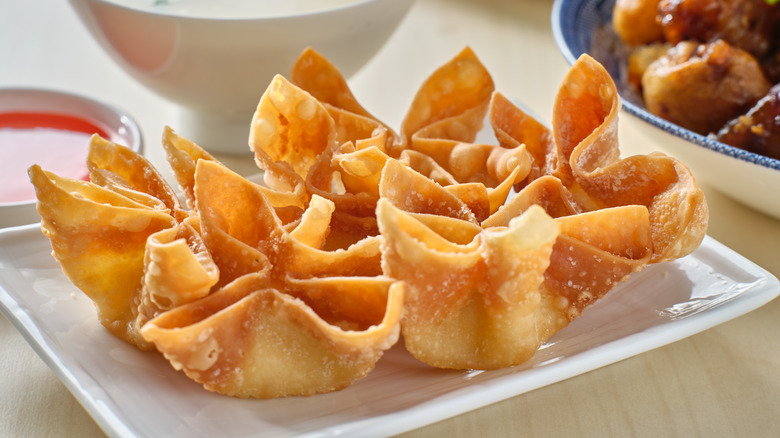How To Seal Crab Rangoon So That Your Delicious Filling Stays Inside
Whether it's the must-have menu item that has you craving takeout or whether you're completely new to crab rangoon, when you try to make it yourself, you'll understand there's a crucial step involved in ensuring the crunchy delight makes it to your plate in one piece. It starts with a standard wonton wrapper and a dab of filling and is followed by the real secret ingredient to keep your rangoon in perfect shape: water.
Unlike the convoluted history of crab rangoon, ensuring a solid seal that keeps fillings safely encased during the cooking process is a simple matter of using the correct technique to seal the edges as you work. Egg yolk, egg white, whole egg, an egg-wash combination of egg and water, or a mixture of cornstarch and water will all do the job, but plain water works fine as long as your wrapper is properly moistened, so don't overcomplicate the process. With a bit of practice, you'll soon be managing a production line of these coveted gems without concern for losing the explosion of flavor enveloped inside.
How to ensure a solid crab rangoon seal
Although it sounds like a line dance, the crab rangoon seal is a different kind of move altogether. However, it's perhaps the most essential part of making your favorite crab rangoon recipe. Before you even begin to press the doughy wrapper edges together, make sure you haven't spooned on too much filling. Save the overstuffing for your belly and lean on the conservative side when dropping your dollop. Folding your wrapper causes the filling to shift around. If it's too full, the filling will burst out the seams, so start small and increase the amount of filling the next time around if you feel it needs more.
To secure the seal, place your ingredient-topped wonton on a flat surface or cup it in the palm of your hand. Then, dip your finger in water and apply a steady coating around the edges. Fold the dough over the filling and press the moistened edges together, reapplying water if necessary as you work. Continue this process for each fold. Then, go back to each seam and give them an additional squeeze, watching for any oozing filling or gaps that need to be sealed up.
Solutions for wrappers that don't seal properly
Whether you make them from scratch or buy them prepackaged at the market, wonton wrappers are the foundation of any crab rangoon. Not to confuse two similar foods, wontons and crab rangoon are different dishes. However, the process of stuffing and sealing them is the same. When working with wonton wrappers, you want them to be thin and pliable, yet sturdy. That means you don't want them so thin they puncture easily. If they do, dial back the pasta roller on your next attempt. If your crab rangoon fillings leak out while cooking, you may have too much air trapped inside the pouch. This air expands while cooking and can cause the ingredients to erupt out the sides. When sealing your rangoon, be sure to push the excess air out from around the filling as you work.
Another reason a seal fails is because the wrapper edges are overly moistened to the point they become mushy and lose their ability to stick. To avoid oversaturating them, use a thin smear of water, just covering the surface to ensure there are no dry spots. It's also important to keep wrappers from drying out, which can contribute to cracking and leaking ingredients. As you work, keep unused wrappers in a sealed bag or covered with a slightly damp cloth. Once they are put together, cook your crab rangoon immediately or freeze them for later use.


